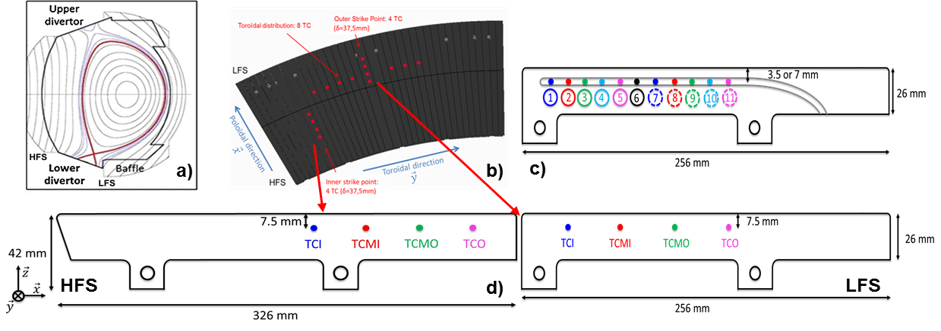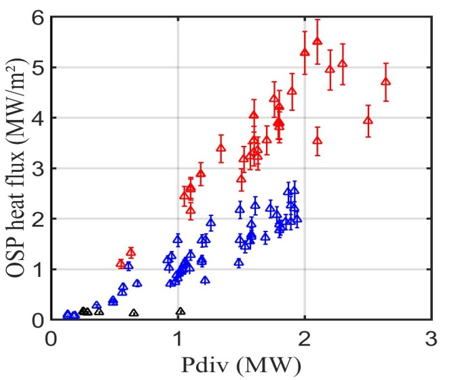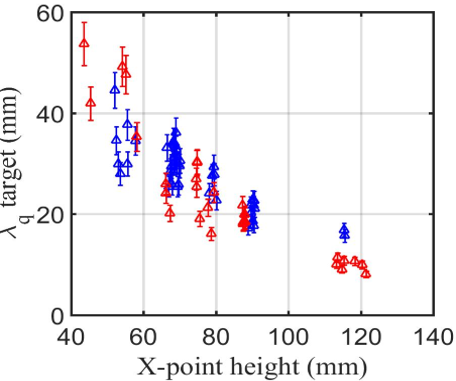Speaker
Description
One of the main goals of WEST is the assessment of power handling capabilities and lifetime of tungsten divertor components under high heat flux and high fluence operation in a full W tokamak environment [ 1 ]. In phase 1, covering the four experimental campaigns (named C1 to C4), WEST operated with a mix of actively cooled ITER like tungsten plasma facing units and inertial tungsten coated graphite components. The preliminary step towards testing the tungsten components is to determine the heat flux deposition pattern. For this purpose, a set of complementary diagnostics allowed characterizing properties of heat loads on the lower divertor: arrays of embedded thermocouples (TC) and Fiber Bragg Gratings (FBG), infra-red thermography on both strike point areas within the same field-of-view, and arrays of flush-mounted Langmuir probes (LP). The flux-mounted Langmuir probes are composed by two separate arrays of 29 probes each with 12.5mm spatial resolution. The embedded thermal measurements are composed by a set of 60 thermal probes such as TC and FBG embedded in the W-coated graphite components and deployed over the lower divertor as shown on figure 1. The strike point position (x0) and the intensity of the peak heat flux (qn), as well as the target heat flux decay length (λ_q^t) are computed simultaneously from the thermal measurements using inverse method based on finite element method solvers. A first heat flux calculation was performed during early diverted ohmic plasma experiments as depicted in [ 2 ]. On this basis, the study has been widely extended and heat flux has been computed for plasma experiments using additional heating power, such as Lower Hybrid (LH) or Ion Cyclotron Resonant Heating (ICRH). A heat flux data base covering the full phase 1 of WEST operation, with deuterium and helium plasmas, is presented in this paper. It includes about 300 plasma experiments achieving at least four seconds of steady state plasma to get significant heating and accurate heat flux calculation from embedded measurements.
In this paper, we report on the first heat flux database built from embedded thermal measurements as a function of the continuous progress achieved in WEST : from the first ohmic diverted plasma (obtained during the second experimental campaign C2 in 2018) up to the high power (up to 6 MW total injected power during 4 s) and high energy (up to 90 MJ total injected energy in lower single null configuration) steady state L-mode plasma experiments performed in the last experimental campaign (C4 in 2019). We report on the heat load pattern, position of the strike point position, peak heat flux and heat flux decay length, on outer and inner sides, as a function of the plasma parameters, heating power (Ptot), divertor power (Pdiv=Ptot-Prad-Pripple losses), plasma current (Ip), density (ne), and divertor magnetic equilibrium (far and close X-point). The consistency between the complementary diagnostics will be discussed on this database and compared with the different uncertainties corresponding to each diagnostics: IR (emissivity distribution evolving with space and time), TC/FBG (inverse method), LP (sheath heat transmission coefficient). Concerning the strike point position, a good agreement (<1cm) is obtained between thermal inversion, magnetic reconstruction and flush-mounted Langmuir probes measurement. The maximum heat flux currently reported on the W-coated graphite components is slightly above 5 MW.m-2. This was obtained with a conducted power on the divertor of ~2MW in two different scenario: 1/ with combined LH and ICRH power and optimized conditioning (low radiated fraction ≈40%) at low X-point height (dX=40mm), 2/ with LH power only and high X-point height to concentrate the scrape-off layer power on targets (dX=120mm).
For the same divertor power, the experimental heat fluxes are higher during C4 than C3 (see figure 2 red and blue points, respectively) while the heat flux decay length reported on the outer target remains similar (see figure 3). A clear improvement of the divertor performances in terms of heat flux capabilities is observed during this period, related to a possible change in the particle and heat transport dynamic. On the outer targets, the heat flux decay length on the targets remains the same and varies almost linearly with the magnetic compression of the field lines, from 60 mm for low compression down to 10 mm for high compression. The outer and inner heat flux ratio is found to be clearly asymmetric (in the 2/3 or two third range) as expected with the drift flows in forward magnetic field [ 3 ]. Those data are used to define WEST divertor operational domain and prepare the WEST phase 2 with an ITER-like fully actively cooled lower divertor allowing higher divertor heat flux (up to 20 MW/m2) and longer discharges (plus length up to 1000 s).
[ 1 ] C. Bourdelle et al, Nuclear Fusion 55 (2015) 063017.
[ 2 ] J. Gaspar et al, Fusion Engineering and Design 146 (2019) 757-760.
[ 3 ] R.A. Pitts et al, Journal of Nuclear Materials 337-339 (2005) 146-153.



| Affiliation | Aix Marseille Univ, CNRS, IUSTI, Marseille, France |
|---|---|
| Country or International Organization | France |
